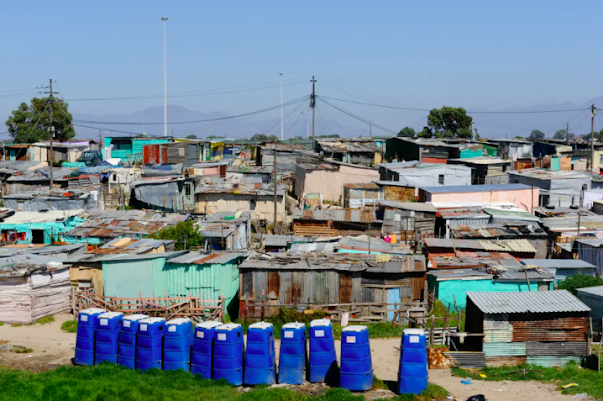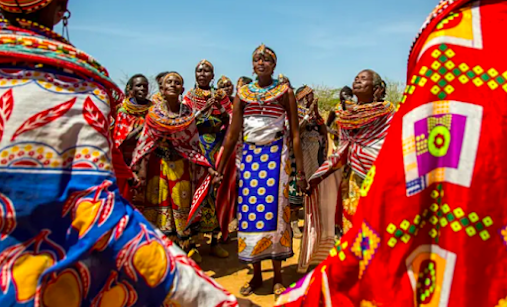8 - The sanitation struggle
For many women around the world, particularly in Africa, accessing sufficient sanitation facilities is a daily struggle. Today I’ll discuss some issues associated with Water, Sanitation and Hygiene (WASH), as well as some interventions that have been deployed.
Biology
Inadequate toilet facilities affect everybody. However, due to biological differences, and different sanitation needs, women are particularly impacted. Throughout menstruation, women need to regularly change sanitary products and wash their hands to avoid infections such as Hepatitis-B, Toxic-Shock Syndrome, and thrush (Water Aid, 2018). Issues of perimenopause and pregnancy can weaken women’s bladders and increase incontinence, exacerbating their need for nearby toilet facilities (Water Aid, 2018). When women urinate, unlike men, they must undress, and so more ‘space, privacy and time’ are needed, particularly during menstruation (Water Aid, 2018).
Inadequate toilets in Khayelitsha, Cape Town (The Conversation, 2020)
Violence
For women, accessing toilets can be dangerous, and occasionally life-threatening. One study conducted in Johannesburg and Ekurhuleni in South Africa found that 29.2% of women shared a toilet, and 0.6% had no toilet (Gibbs et al, 2020). Shared toilets and open defecation particularly affect women where cultural norms require them waiting until dark to go (Water Integrity Network, 2019). When toilets are far and unlit, sexual violence is common. The same study found ‘lifetime non-partner rape perpetration by men as high as 21%’, and a strong intersection between inadequate WASH facilities and violence against women and girls (Gibbs et al, 2020). Such conditions cause dehydration, as women limit their water intakes to reduce their need to urinate (Water Integrity Network, 2019). This further impacts health, increasing the risk of ‘urinary tract problems, chronic constipation, and other gastric disorders’ (Water Integrity Network, 2019).
Innovations in South Africa
On the bright side, many successful attempts have been made to improve community sanitation. For a decade, the Bill & Melinda Gates Foundation has worked on multiple sanitation projects with the University of Kwazulu-Natal, South Africa (University of Kwazulu-Natal, 2021). The Foundation granted the University’s Pollution Research Group (PRG) US$400,000 ‘to fund an innovative and ground-breaking initiative’, taking ‘toilet technology and sanitation to a new level’ (Bill and Melinda Gates Foundation, 2011). The university designed ‘ablution blocks’ made from ‘repurposed shipping containers’ (University of Kwazulu-Natal, 2021; Water Aid, 2018). The toilets could be used for free and were provided with regular cleaning and maintenance (Water Aid, 2018). Women and girls are often responsible for cleaning toilet facilities, so providing cleaning benefits women in other ways (Water Integrity Network, 2019). 2500 community containers were provided across 500 settlements helping over 1 million people, reducing proximity to 75m (1.5 minutes walk) or less (Water Aid, 2018).
“Female friendly” toilets
The development and de-stigmatization of "female-friendly" public toilets have also benefitted women. They entail a ‘safe and conveniently located toilet, separated by gender’, providing ‘privacy (doors, locks), a culturally appropriate menstrual waste disposal option (trash bins, chutes, pits), water and soap… for washing blood off one’s hands (water tap or bucket), [and] suitable drainage and accessibility both during the day and night (area and internal lighting)' (Schmitt et al, 2018). They are completely separate, well labelled, and run by ‘trained male and female caretakers’ (Water Vision, 2018). CCTV installation is suggested to further ensure a safe environment (Water Vision, 2018).
Sarah Quaye using a “female-friendly” toilet in Liberia’s Weinzon Community (Water Aid, 2018).
Education
While innovations can help where women’s biological needs require close proximity to toilets, it is imperative that men are educated if the problem of gender-based sexual violence is to be solved. In Kenya, programmes have been introduced into schools to help change the perceptions of men and boys, teaching them the importance of respecting women’s bodies. One programme called ‘Your Moment of Truth’ was introduced for boys aged 14-18, focusing on sex education, the importance of consent, and knowing how to intervene potential assaults (BBC, 2018). One member of the Kibera slum in Nairobi, Kenya – 15-year-old Isaac – implemented his new intervention skills and helped save a young girl from rape as he ‘watched a group of men’ grab her (BBC, 2018).
To conclude
I hope that in this blog post I have effectively discussed how inadequate sanitation facilities disproportionately affect women. Through their biological differences and the gender-based violence that they are vulnerable to, women's access to water and sanitation is unequal. I am convinced that the combination of safe, "female-friendly" toilets and improved male education will help resolve their disparate access. Obviously, sanitation facilities need to be improved and adequate for all, however, it cannot be ignored that women are at an unfair disadvantage when it comes to accessing the basic right.




Comments
Post a Comment